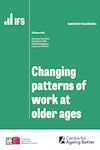Sign up to receive the latest news, research, policy updates and events about ageing.
SubscribeContact our team for more information
Contact usLonger working lives offer many benefits, but achieving these can pose challenges for individuals, employers and policymakers. In order to support people in their 50s and 60s to remain in paid work for longer, it's critical that we have a good picture of what paid work looks like at older ages, and how that might evolve in future.
This report provides fresh evidence on the nature of paid work at older ages, how employment patterns differ for people in different circumstances and how the situation is changing over time. In particular, it examines in-depth the transitions that older workers make, both into and out of work and between different types of employment in the run-up to retirement.
Key findings include:

Sign up to receive the latest news, research, policy updates and events about ageing.
SubscribeContact our team for more information
Contact us